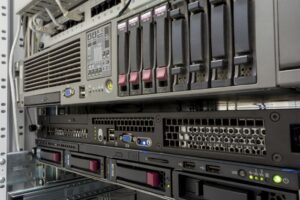Orange County RAID Server Recovery


The process of RAID server recovery involves recovering important data from failed or corrupted storage media. In some of the most urgent and important cases, data needs to be recovered from hard drives used within a company’s server system.
What is RAID?
RAID stands for Redundant Array of Independent Discs. This is a method of combining multiple independent hard drives into one unit for storage purposes. There are several advantages of employing a RAID server. First is storage redundancy: since you can configure a RAID setup to write information on more than one disc, they are more reliable than a single-disk server. Second, the read/write performance of a RAID setup can exceed the speeds of a single-disk setup.
However, even though RAID servers are built for greater reliability and redundancy, this does not mean they are exempt from failure. Hard drive capacity has increased over the past few years, and the rates of error for hard drives has remained close to the same. While a single drive’s failure within a RAID array can be fixed by swapping out a hard drive and attempting to rebuild the data upon it, if another drive fails during the down time this can mean a loss of all data on those two drives. At some points, a system crash can cause errors that interrupt writes between hard drives in the RAID array. In these cases, it is necessary to employ a RAID server recovery process.
Around forty to forty-five percent of RAID server failures happen because of mechanical damage, and in these cases it is often not possible to use data recovery software to recover these files.
Recovery of Files on a RAID
While the server might not be able to immediately access data stored within the RAID array, that does not mean the data is permanently gone. Multiple reasons exist in which the data might no longer be accessible to the user. This could be a software failure, such as the server’s operating system crashing. This would render the server unable to boot up or be used in the typical functional manner. In the case of a hardware failure, either the drives themselves could have developed an error, or suffered damage of some sort from trauma, fire, water, or a similar accident. In the case of software error, files can be accessible from an external computer to transfer files to a working storage medium. In other cases data carving must be employed in the RAID server recovery process to reconstruct filesystem errors to retrieve the data.
In cases of physical damage, the hard drive can be reconstructed by opening it up in a clean room and replacing components. In a worst case scenario, a special disk-imaging procedure can be used to transfer all readable data from the drive platter.
Since some of a company’s most valuable information can be kept on a RAID server, the process of RAID server recovery is one of the most important things to successfully execute in the event of a catastrophic failure.